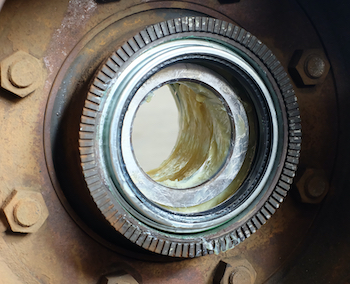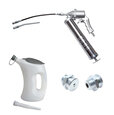Silicone Grease and Oil

Figure 1: Silicone grease used on wheel bearings
Silicone grease is a type of viscous lubricant that is made with a combination of silicone oil and an inert filler, such as silica powder and thickeners such as lithium soap. The grease is generally a thick, white paste. However, it is possible for the color to change depending upon the proportions and type of thickener and oil being used. The thickener is a material that gives grease its texture by thickening it. This mixture of silicone oil and thickener forms chains of linear polymers that can easily slide against each other giving the grease its lubricating properties.
Silicone greases have good sealing properties, are waterproof, offer excellent fluidity and thermal stability for a wide temperature range. They also provide excellent resistance against chemicals and UV radiations as compared to organic lubricants. Because of this excellent thermal conductivity and performance range, silicone grease can be used as a lubricant or electrical insulator in highly demanding applications. It can be commonly seen being used in plumbing works to avoid leakage, sealing of pipelines, as well as during installations in manufacturing assemblies. Learn more about lubricants in our lubrication guide, or our extensive three part series on Tribology.
Note: Currently we do not sell any lubricants.
View our online selection of lubricants!
What is silicone oil?
Figure 2: Polydimethylsiloxane (PDMS)
Silicone grease uses silicone oil as a base. Compared to other synthetic oils, a silicone oil base provides excellent lubricating properties and thermal stability for a wide temperature range. The silicone oil in itself is the mixture of polydimethylsiloxanes (Figure 1) with dimethicone or simethicone which gives it lubricating, water-repellant, non-toxic, and anti-foaming properties. These properties make silicone oil and silicone lubricating grease suitable to use in automotive, aerospace, marine, food service, or medical industries.
Why use silicone grease?
The different type of fillers and synthetic oils used in the grease can greatly affect their performance with regards to temperature variations. Silicone-based grease has many advantages, such as:
- Silicone grease can be used for a wide temperature range, generally from -60°C to 300°C even with varying pressure or load conditions.
- Silicone grease with PTFE (Polytetrafluoroethylene) filler can be used for electrical applications due to their electrically insulating properties.
- The silicone oil present in the grease is water repellant, thus, can be used in applications where long-term protection against oxidation is desired.
- In some cases, silicone lubricant grease with high viscosity can also be used as a sealant.
- The non-toxic nature of silicone grease makes it possible to use in medical applications as well as in food-grade facilities.
Applications of silicone grease
Figure 3: Silicone grease can be used to lubricate gears, valves, or machinery components such as bearings.
Silicone grease has its effectiveness even in extreme environmental conditions due to the many advantages it offers. Here are few common examples of applications of silicone grease:
- To protect the high voltage electrical components
- To seal or protect o-rings in valves, faucets
- To lubricate gears, valves, or machinery components such as bearings
- Use in petroleum jelly
- Use in chemical lab or experiments to repel dust or other inclusions
- Use in guns, joints, bolts, hinges for lubrication and corrosion resistance
- To vacuum seal glass joints





